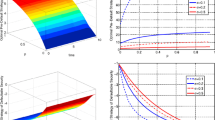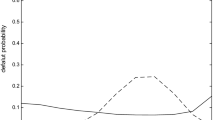Abstract
We propose a model of inter-bank lending and borrowing which takes into account clearing debt obligations. The evolution of log-monetary reserves of banks is described by coupled diffusions driven by controls with delay in their drifts. Banks are minimizing their finite-horizon objective functions which take into account a quadratic cost for lending or borrowing and a linear incentive to borrow if the reserve is low or lend if the reserve is high relative to the average capitalization of the system. As such, our problem is a finite-player linear–quadratic stochastic differential game with delay. An open-loop Nash equilibrium is obtained using a system of fully coupled forward and advanced-backward stochastic differential equations. We then describe how the delay affects liquidity and systemic risk characterized by a large number of defaults. We also derive a closed-loop Nash equilibrium using a Hamilton–Jacobi–Bellman partial differential equation approach.

Similar content being viewed by others
References
Carmona, R., Fouque, J.P., Sun, L.H.: Mean field games and systemic risk. Commun. Math. Sci. 13(4), 911–933 (2015)
Fouque, J.P., Sun, L.H.: Systemic risk illustrated. In: Fouque, J.-P., Langsam, J. (eds.) Handbook on Systemic Risk. Cambridge University Press (2013)
Fouque, J.P., Ichiba, T.: Stability in a model of inter-bank lending. SIAM J. Financ. Math. 4, 784–803 (2013)
Garnier, J., Papanicolaou, G., Yang, T.W.: Diversification in financial networks may increase systemic risk. In: Fouque, J.-P., Langsam, J. (eds.) Handbook on Systemic Risk. Cambridge University Press (2013)
Garnier, J., Papanicolaou, G., Yang, T.W.: Large deviations for a mean field model of systemic risk. SIAM J. Financ. Math. 4, 151–184 (2013)
Peng, S., Yang, Z.: Anticipated backward stochastic differential equations. Ann. Probab. 37(3), 877–902 (2009)
Gozzi, F., Marinelli, C., Savin, S.: On control linear diffusions with delay in a model of optimal advertising under uncertainty with memory effects. J. Optim. Theory Appl. 142(2), 291–321 (2009)
Carmona, R.: Lectures on BSDEs, Stochastic Control, and Stochastic Differential Games with Financial Applications. SIAM Book Series in Financial Mathematics 1 (2016). http://bookstore.siam.org/fm01/
Øksendal, B., Sulem, A.: Maximum principle for optimal control of stochastic systems with delay with applications to finance, pp. 64–79. Optimal Control and PDE, Essays in Honour of Alain Bensoussan (2001)
Øksendal, B., Sulem, A., Zhang, T.: Optimal control of stochastic delay equations and time-advanced backward stochastic differential equations. Adv. Appl. Probab. 43(2), 572–596 (2011)
Larssen, B.: Dynamic programming in stochastic control of systems with delay. Stoch. Stoch. Rep. 74(3–4), 651–673 (2002)
Larssen, B., Risebro, N.: When are hjb-equations for control problems with stochastic delay equations finite-dimensional? Stoch. Anal. Appl. 21(3), 643–671 (2003)
Gozzi, F., Marinelli, C.: Stochastic control of delay equations arising in advertising models-vii. lect. notes pure appl. math. Stoch. Partial Differ. Equ. Appl. 245, 133–148 (2006)
Gozzi, F., Masiero, F.: Stochastic optimal control with delay in the control: solution through partial smoothing. SIAM J. Control Optim. 55(5), 2981–3012 (2015)
Chen, L., Wu, Z.: The quadratic problem for stochastic linear control systems with delay. In: Proceedings of the 30th Chinese Control Conference, Yantai, China (2011)
Chen, L., Wu, Z., Yu, Z.: Delayed stochastic linear-quadratic control problem and related applications. J. Appl. Math. (2012)
Xu, X.: Fully coupled forward-backward stochastic functional differential equations and applications to quadratic optimal control. arXiv:1310.6846v2 (2013)
Bensoussan, A., Chau, M., Lai, Y., Yam, P.: Linear-quadratic mean field Stackelberg games with state and control delays. SIAM J. Control Optim. 55(4), 2748–2781 (2016)
Peng, S., Wu, Z.: Fully coupled forward–backward stochastic differential equations and applications to optimal control. SIAM J. Control Optim. 37(3), 825–843 (1999)
Vinter, R., Kwong, R.: The infinite time quadratic control problem for linear systems with state and control delays: an evolution equation approach. SIAM J. Control Optim. 19(1), 139–153 (1981)
Gozzi, F., Marinelli, C.: Stochastic optimal control of delay equations arising in advertising models. Stoch. PDEs Appl. VII. Levico Terme Italy 245, 133–148 (2004)
Fabbri, G., Federico, S.: On the infinite-dimensional representation of stochastic controlled systems with delayed control in the diffusion term. Math. Econ. Lett. 2, 3–4 (2014)
Fabbri, G., Gozzi, F., Swiech, A.: Stochastic optimal control in infinite dimension. In: Probability and Stochastic Modelling. Springer (2017)
Alekal, Y., Brunovsky, P., Chyung, D., Lee, E.: The quadratic problem for systems with time delays. Autom. Control IEEE Trans. 16(6), 673–687 (1971)
Huang, J., Li, X., Shi, J.: Forward-backward linear quadratic stochastic optimal control problem with delay. Syst. Control Lett. 61(5), 623–630 (2012)
Da Prato, G., Zabczyk, J.: Stochastic Equations in Infinite Dimensions. Cambridge University Press, Cambridge (2014)
Bensoussan, A., Yam, S.C.P., Zhang, Z.: Well-posedness of mean-field type forward–backward stochastic differential equations. Stoch. Process. Appl. 25(9), 3327–3354 (2015)
Acknowledgements
The authors would like to thank Romuald Elie and Phillip Yam for conversations on this subject. We also thank an anonymous referee for his/her comments and suggestions which helped make the paper clearer. The work of the Jean-Pierre Fouque was supported by NSF Grant DMS-1409434. The work of the Li-Hsien Sun was supported by MOST-103-2118-M-008-006-MY2.
Author information
Authors and Affiliations
Corresponding author
Appendix: Proof of Lemma 4.1
Appendix: Proof of Lemma 4.1
Proof
Assuming that \((\check{X},\check{Y}, (\check{Z}^{k})_{k=1,\ldots ,N})\) is given as an input, we solve the system (29) for \(\lambda =\lambda _0\) and the processes \(\phi _t\), \(\psi ^k_t\), \(r_t\) and the random variable \(\zeta \) replaced according to the prescriptions:
and denote the solution by \(({X},{Y}, ({Z}^{k})_{k=1,\ldots ,N})\). In this way, we defined a mapping
and the proof consists in proving that the latter is a contraction for small enough \(\kappa >0\).
Consider \((\widehat{X},\widehat{Y},(\widehat{Z}^{k})_{k=1,\ldots ,N})=({X}-{X}^\prime ,{Y}-{Y}^\prime , (Z^{k}-{Z}^{k\prime })_{k=1,\ldots ,N})\) where \((X,Y,(Z^{k})_{k=1,\ldots ,N})\) and \(({X}^\prime ,Y^\prime ,({Z^{k}}^\prime )_{k=1,\ldots ,N})\) are the corresponding image using inputs \((\check{X},\check{Y},(\check{Z}^{k})_{k=1,\ldots ,N})\) and \(({\check{X}^{\prime }},{\check{Y}^{\prime }},(\check{Z}^{k\prime })_{k=1,\ldots ,N})\). We obtain
with initial condition \(\widehat{X}_0=0\) and terminal conditions \( \widehat{Y}_T=(1-\lambda _0)\widehat{X}_T+\lambda _0c\left( 1-\frac{1}{N}\right) \widehat{X}_T-\kappa \widehat{\check{X}}_T+\kappa c(1-\frac{1}{N})\widehat{\check{X}}_T\) and \(\widehat{Y}_t=0\) for \(t\in (T,T+\tau ]\) in the case of \(c >0\), and \(\widehat{Y}_T=0\) and \(\widehat{Y}_t=0\) for \(t\in (T,T+\tau ]\) in the case of \(c=0\). As we stated in the text, we only give the proof in the case \(c=0\) to simplify the notation. The proof of the case \(c>0\) is a easy modification. Using the form of the terminal condition and It\(\hat{\mathrm {o}}\)’s formula, we get
and rearranging the terms we find: and rearranging the terms we find:
Letting \(\mu = \epsilon (1-\frac{1}{N})-q^2(1-\frac{1}{2N})^2>0\), we obtain:
and a straightforward computation using repeatedly Cauchy–Schwarz and Jensen’s inequalities leads to the existence of a positive constant \(K_1\) such that
Referring to [27], applying It\(\hat{\mathrm {o}}\)’s formula to \(|\widehat{X}_t|^2\) and \(|\widehat{Y}_t|^2\), Gronwall’s inequality, and again Cauchy–Schwarz and Jensen’s inequalities, owing to \(0\le \lambda _0\le 1\), we obtain a constant \(K_2>0\) independent of \(\lambda _0\) so that
By using (64), there exists \(0<\mu '<\mu /{K_2}\) such that
Therefore, we have
Note that since \(\mu -K_2\mu '\) and \(\mu '\) stay in positive, we have \((1-\lambda _0+\lambda _0(\mu -K_2\mu '))\ge \mu ''\) and \((1-\lambda _0+\lambda _0\mu ')\ge \mu ''\) where for some \(\mu ''>0\). Combining the inequalities (64–66), we obtain
where the constant K depends upon \(\mu '\), \(\mu ''\), \(K_1\), \(K_2\), and T. Hence, \(\varPhi \) is a strict contraction for sufficiently small \(\kappa \). \(\square \)
Rights and permissions
About this article
Cite this article
Carmona, R., Fouque, JP., Mousavi, S.M. et al. Systemic Risk and Stochastic Games with Delay. J Optim Theory Appl 179, 366–399 (2018). https://doi.org/10.1007/s10957-018-1267-8
Received:
Accepted:
Published:
Issue Date:
DOI: https://doi.org/10.1007/s10957-018-1267-8




